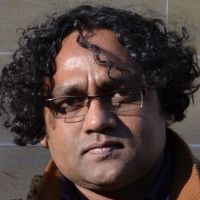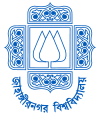
Md. Mizanur Rahaman, MSc (UCL), DPhil (Oxon) Associate Professor, Department of Archaeology
PROFILE
SHORT BIOGRAPHY
Md. Mizanur Rahman is a professional archaeologist and the first archaeobotanist in Bangladesh. He is an associate professor in the Department of Archaeology at Jahangirnagar University. Dr. Rahman earned his DPhil (PhD) in Archaeological Science from the School of Archaeology of the University of Oxford. His doctoral research, supervised by eminent archaeobotanists Prof. Amy Bogaard and Prof. Michael Charles, was titled “Early Rice Agriculture of Bangladesh: Methodological and Archaeobotanical Perspectives.”
In his research, Dr. Rahman employed advanced techniques, including charring, morphometrics, and geometric morphometric (GMM) analysis, to investigate early rice cultivation in Bangladesh. His work focuses on identifying ancient rice varieties, examining their management practices, and exploring their evolutionary trajectories through detailed phenotypic analysis. Dr. Rahman’s groundbreaking contributions provide invaluable insights into the history and development of rice agriculture in the region.
Dr. Mizanur graduated with distinction from Jahangirnagar University and the Institute of Archaeology, University College London (UCL). At UCL, he received practical training in archaeological seed identification and phytolith processing, honing his expertise in the meticulous study of ancient plant remains.
Dr. Rahman studied archaeobotany under the guidance of globally renowned experts, including Professor Dorian Q Fuller at UCL and Professors Amy Bogaard and Michael Charles at the University of Oxford. His world-class education and training have empowered him to pioneer innovative research in the field of Bangladeshi archaeology, making significant contributions to the understanding of the region's ancient agricultural practices.
Rahman spearheaded the establishment of Bangladesh’s first archaeobotany laboratory at the Department of Archaeology, Jahangirnagar University, marking a significant milestone in the nation's archaeological research capabilities. He has cultivated a robust and highly regarded network of research collaborations both domestically and internationally, partnering with scholars and institutions across the UK, France, Germany, Belgium, China, and Iran. These partnerships have greatly enriched the scope and impact of his work, fostering cross-cultural and interdisciplinary advancements in archaeobotanical studies.
Dr. Rahman is deeply committed to unraveling the historical complexities of early Bangladesh through the application of advanced archaeological science techniques. His research explores pivotal themes such as the origins of human habitation, prehistoric lifestyles, and the gradual transition from sedentary communities to urban societies.
Dr. Rahman’s work delves into the strategies employed by early inhabitants to adapt to environmental changes and natural disasters, examining how they managed livelihoods amidst the challenges posed by Bangladesh’s dense population. He is also profoundly interested in the archaeology of religion, focusing on the emergence, evolution, and decline of Buddhism, Brahmanism, and Islam in early Bangladesh. By integrating rigorous scientific methods, he aims to uncover the sociological dimensions of these religions with concrete archaeological evidence, offering groundbreaking insights into their historical trajectories and societal impacts.
RESEARCH INTEREST
Archaeobotany, Archaeological Science, Isotope analysis, Field archaeology, Ethonobioarchaeology, Palaeoecology, Palaeodiet, Hunter-gatherer archaeology, Buddhism, Hinduism and Islam in Bengal, Urbanization, Social complexity, Inequality of the Early Bengal.
JOURNAL PAPER
Mizanur Rahman & Bulbul Ahmed, মাঠ থেকে পাতে: আদি বাংলার খাদ্য ও খাদ্য সংস্কৃতির স্বরূপ সন্ধানে, Pratnattva, 26, pp.1-18, 2020.Rahman, M., Cristina, C.C., Murphy, C., Rahman, S.M., Fuller,D.Q., Agricultural systems in Bangladesh: the first archaeobotanical results from Early Historic Wari-Bateshwar and Early Medieval Vikrampura., Archaeological and Anthropological Sciences., Vol. 12., 2020. doi: https://doi.org/10.1007/s12520-019-00991-5
Rahman, M., Murphy, C., Weisskopf, A., Champion, L., Castillo, C., Fuller, D.Q., Wari-Bateshwar and Vikrampura: Successful Case Studies in Bangladesh Archaeobotany., Man and Environment., Vol. XLIV, (1), pp.62-72., 2019..
Rahman, M., New research in Bangladesh archaeobotany: potential issues and future scope., Journal of Bengal Art, Vol. 25, pp.393-410., 2020.
Rahman, M., Early farming communities in the Ganga plain: Origin of agriculture, crops domestication and Pastoralism., Journal of Bengal Art., Vol. 19, pp.231-246, 2018..
Rahman, M., Early Buddhist archaeological remains from the heartland of Buddhism: nature and reason of the scarcity of archaeological visibility., Journal of History and Civilization., Vol. 13, pp.23-30, 2018.
Rahman, M., Come across the capital of vijayasena: uncover the forgotten historic landscapes., Green University Review of Social Sciences., Vol. 03, (01), pp.69-80, 2016.
Rahman, M. and Rahman, S.M., Settlement Pattern of Kotalipada Mud Rampart Area: An ethnoarchaeological analysis., Pratnatattva., 19, pp.65-74,
Rahman, M., Surface Archaeology of Kotālipādā, Gopalganj, Bangladesh., Sneha Sri Commemoration volume, 1,
CONFERENCE PAPER
Rahman, M., Archaeobotanical evidence for rice in Bangladesh, International Rice workshop 2019, M.S. University, Dept. of Archaeology, Vadodhara, Gujrat, India., 2019..The aim of this presentation is to show the archaeobotanical rice remains found in Bangladesh in the last couple of years and discuss some issues relating to traditional rice cultivation and recovered archaeobotanical rice data. Rice is the foremost staple crop in Bangladesh which provides half of the rural employment in the country. Last ten years, archaeobotanical samples have been collected from 12 archaeological sites, ranging between C. 500BC to 1800AD, while it shows 100% ubiquity of rice presence in the sampled site. Despite collecting samples from many sites, we are yet to able to study of the Archaeobotanical rice remains from two sites; Wari-Bateshwar (WB) and Setesher Danga (SD). The earliest rice assemblage found from WB (C.400BC-200BC) with South East Asian rice varieties Oryza Sativa japonica. Later, predominant O. sativa indica found from SD (1300AD-1800AD) along with O.sativa japonica and O. sativa aus. The available archaeobotanical data shows the rice could have been carried into Bangladesh and no evidence yet to have been found regarding indigenous development. Weed data from SD infers lowland irrigated rice weed flora was predominant despite the presence of significant upland rice weed along with small numbers of deepwater rice weed and tidal rice weed which suggest that the general rice cultivation ecology of SD was dominated by lowland irrigated rice cultivation system regardless of period. Our present rice morphometrics analysis is not assimilating with the traditional rice cultivation practice of Bangladesh as it was dominated by aus rice farming practice. Thus, it is strongly suggested that the criteria for present rice morphometrics should be reevaluated.
BOOK CHAPTER
Mizanur Rahman, মধ্যযুুগীয় কৃৃষি: প্র্ত্ন-্উদ্ভিজ্জ্ সমীক্ষা, বাংলাদেশের ্ইতিহাস (সুুলতানী ও মোগল যুুগ-১২০০-১৮০০ খ্রি.), ২, pp.৭৫-৯৪, ২০২০.Mizanur Rahman, Medieval agriculture: An archaeobotanical study, History of Bangladesh (Medieval period), 2, pp.pp.87-108, 2020.
Rahman, S.M. and Rahman, M., Miscellaneous Artifacts., Archaeological Heritage/Asiatic Society of Bangladesh, Dhaka, Bangladesh. , 2008.
Teaching
| Course Code | Course Title | Semester/Year |
|---|---|---|
| 511 | Environmental Archaeology (Practical Archaeobotany part) | Masters |
| 509 | Field work | Masters |
| 409 | Field work | 4th year |
| 306 | World civilization; Medieval period. | 3rd year |
| 206 | Geography and Geology of Bangladesh | 2nd year |
| 101 | Principles and History of Archaeology | 1st year |
| 106 | Basic Geology for Archaeology | 1st year |
Academic Info
Period: 2019-2024
DPhil in Archaeological Science (ongoing)
Supervisors: Professor Dr. Amy Bogaard (Head, School of Archaeology, University of Oxford) and Professor Dr. Mike Charles
The topic of thesis: Archaeobotanical perspectives of Early Bangladesh; Early-Historic to Early-Medieval Period (c.500BC-AD1200).
Period: 2017-2018
MSc in Environmental Archaeology
Result: Distinction
MSc Thesis Topic: Agricultural Extension in Medieval Northern Bangladesh: Archaeobotanical Evidences from Sotisher Danga (SD).
Supervisor: Professor Dorian Q. Fuller
Laboratory of Archaeobotany and Palaeoecology, UCL, IoA.
Period: 2004-2005 (Exam held in 2007)
M.S.S. in Archaeology
Result: 1st class 3rd
Department of Archaeology
Period: 1999-2000 to 2003-2004 (Exam held in 2006)
B.S.S. Hon's in Archaeology
Department of Archaeology
Result: 1st class 1st
Experience
Position: Associate Professor
Period: May 2018 to till now
Position: Assistant Professor
Period: July 2014 to May 2019
Position: Lecturer
Period: 18 May 2011 to July 2014
Position: Research Assistant
Period: January-May 2018
Part-time
Position: Deputy Director
Period: 2010-2011
Position: Assistant Director
Period: 2008-2009
Position: Research Assistant
Period: 2004-2007
Activity
Position: member
Period: 2020 to till
Position: member
Period: 2020 to till
Position: member
Period: 2019 to life member
Contact
Md. Mizanur Rahaman, MSc (UCL), DPhil (Oxon)
Associate Professor
Department of Archaeology
Jahangirnagar University, Savar, Dhaka-1342, Bangladesh.
Cell Phone: 01797189844
Email: zamiju29@juniv.edu
, zami29ju@gmail.com/ md.mizanur@hertford.ox.ac.uk

